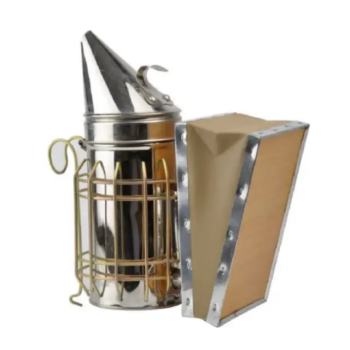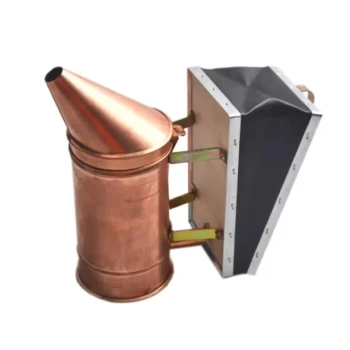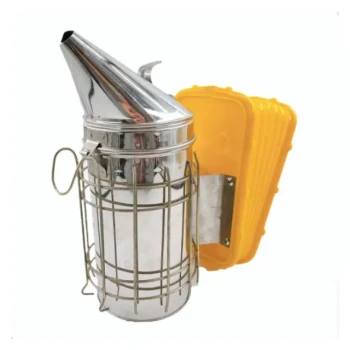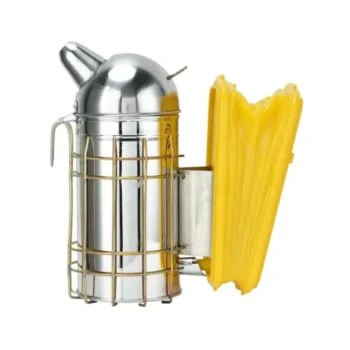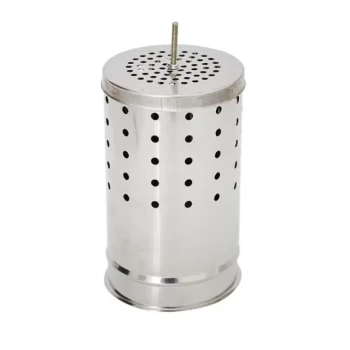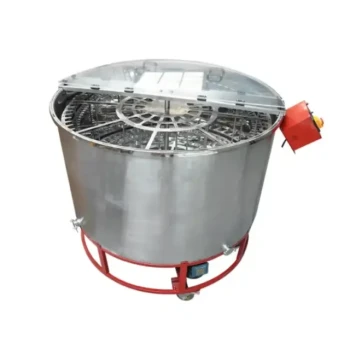In short, you should use a bee smoker almost every time you open a hive. A smoker is the primary tool for calming bees during routine inspections, honey harvesting, queen introductions, and when combining colonies. Its purpose is to interrupt the bees' defensive communication, ensuring a safer and less stressful experience for both the beekeeper and the hive.
The core principle is not about subduing the bees, but about temporarily masking their alarm signals. Proper use of a smoker allows you to work alongside the colony, rather than against it, by preventing a widespread defensive response before it begins.

How Smoke Actually Calms a Beehive
To use a smoker effectively, you must understand what it's actually doing. It works on two biological levels.
It Masks Alarm Pheromones
When a guard bee perceives a threat, it releases an alarm pheromone (isopentyl acetate) to alert the colony. This is the signal that triggers a coordinated defensive response.
The smoke effectively overwhelms the bees' sense of smell, making it impossible for them to detect and react to the alarm pheromones. This prevents a small disturbance from escalating into a full-blown attack.
It Triggers a Feasting Instinct
The presence of smoke also triggers a primal survival instinct in the bees. They associate smoke with a forest fire, a major threat to their home.
In response, they begin to gorge on honey in preparation to abandon the hive. A bee with a full belly is physically less able to flex its abdomen to sting and is generally more docile, focusing on survival rather than defense.
Key Scenarios for Using a Smoker
While a smoker is a standard tool for most hive interactions, its application is especially critical in specific, high-stress situations.
Routine Hive Inspections
This is the most common use. A few puffs of smoke at the entrance and under the lid before you begin work is standard procedure to set a calm tone for the inspection.
Honey Harvesting
Extracting honey is a highly disruptive process. Using a smoker is essential to keep the colony calm and manageable while you remove frames.
Combining Hives or Splits
When introducing bees from different colonies, their distinct scents can cause them to fight. Smoke helps mask these scents, promoting acceptance and reducing aggression between the two groups.
Managing Unpredictable Colonies
If you are working with a hive that is known to be aggressive or "hot," a smoker is a non-negotiable safety tool. It allows you to maintain control and complete your work without excessive stings.
Understanding the Common Pitfalls
Using a smoker is a skill. Misusing it can be counterproductive or even harmful to your bees.
The "Too Much Smoke" Problem
More is not better. Using too much smoke can overly agitate the colony, drive the queen to hide, or even cause the bees to flee the frames you need to inspect. It can also impart an undesirable smoky flavor to honey.
The Temperature of the Smoke
The goal is to produce cool, white smoke. Hot smoke or embers from the smoker can burn the bees' delicate wings. Always test the smoke temperature on the back of your hand before directing it at the hive.
Physical and Fire Safety
A lit smoker is a significant fire hazard. It gets extremely hot and should never be left unattended on a flammable surface. Always ensure it is placed securely and is fully extinguished after use.
The Correct Technique for Application
Proper use is about gentle, deliberate communication with the hive.
The Initial Approach
Before you even touch the hive, send one or two gentle puffs of cool smoke into the entrance. This serves as your initial announcement. Wait 30-60 seconds before proceeding.
Opening the Hive
After waiting, crack the outer and inner covers. Before fully removing the inner cover, send a few more gentle puffs of smoke across the top of the frames. This disperses the guard bees that rush to the top.
During the Inspection
Set the smoker aside but keep it within easy reach. As you work through the hive, you may notice bees starting to line up on top of the frames, looking at you. This is a sign their defensiveness is returning.
Apply a small puff of smoke across the frames to gently push them back down and maintain a calm environment. If you get stung, smoke the area on your suit or skin to mask the alarm pheromone released by the sting.
Making the Right Choice for Your Goal
Your approach should adapt to the specific temperament of the hive and the task at hand.
- If your primary focus is a quick, routine inspection on a calm day: Use minimal smoke—just a few puffs at the entrance and under the lid is often sufficient.
- If your primary focus is honey harvesting or managing an aggressive hive: Be prepared with a well-lit smoker that will last the entire time, applying gentle puffs as needed to maintain control.
- If your primary focus is a delicate operation like introducing a new queen: Use smoke strategically to mask scents and prevent initial aggression, creating a neutral environment for acceptance.
Ultimately, a smoker is a tool for communication, used to ensure the well-being and safety of both the bees and the beekeeper.
Summary Table:
| Scenario | Why Use a Smoker? | Key Benefit |
|---|---|---|
| Routine Hive Inspections | To set a calm tone and prevent defensive response. | Safer, less stressful inspections. |
| Honey Harvesting | To manage bees during a highly disruptive process. | Easier frame removal, controlled colony. |
| Combining Hives/Splits | To mask different colony scents and reduce aggression. | Promotes acceptance between bee groups. |
| Managing Aggressive Colonies | As a primary safety tool for unpredictable hives. | Maintains beekeeper control, reduces stings. |
Master hive management with the right equipment from HONESTBEE.
Whether you're a commercial apiary managing hundreds of hives or a distributor supplying beekeepers, having reliable, high-quality smokers and protective gear is fundamental to safe and productive operations. HONESTBEE supplies the durable, wholesale-focused beekeeping supplies and equipment you need to work confidently.
Let us equip your business for success. Contact our team today to discuss your wholesale needs and how our products can support your beekeeping goals.
Visual Guide
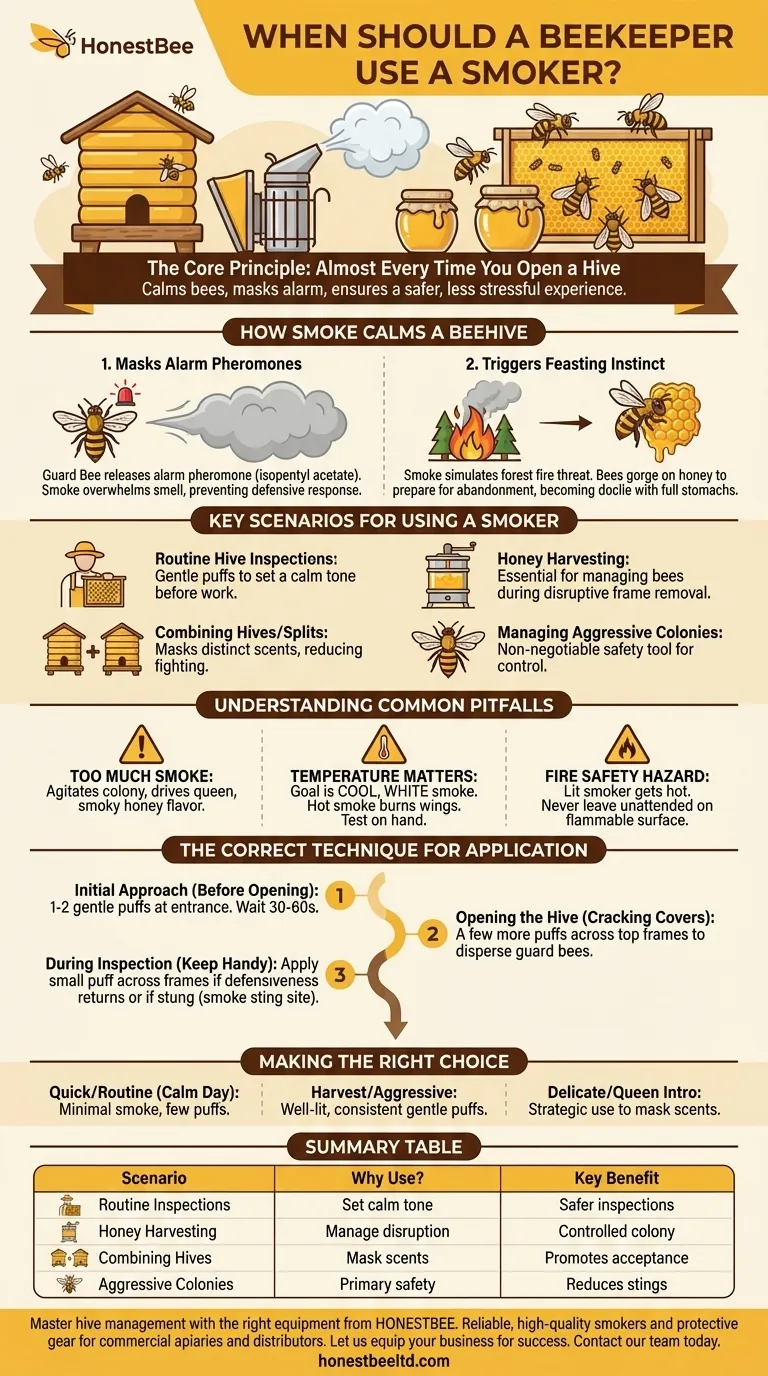
Related Products
- European Stainless Steel Bee Smoker for Honey Bee Hive
- Stainless Steel Honey Bee Smoker Hive and Honeycomb Smoker for Beekeeping
- Economy Galvanized Beekeeping Honey Bee Smoker for Wholesale
- Electric Bee Smoker European Style Bee Hive Smoker for Beekeeping
- Premium Traditional Copper Bee Smoker with Bellows
People Also Ask
- What are the features of a recommended bee smoker? A Guide to Safety, Durability & Performance
- What are the benefits of smoking bees? Achieve Safer, Calmer Hive Inspections
- How does a smoker help during hive inspections? The Key to Calm, Safe Beekeeping
- What factors should be considered when choosing a bee smoker? Find the Right Tool for Safe, Effective Hive Management
- What are the advantages of a high-quality bee smoker? Achieve Calm, Confident Hive Management

